Root crops have a high requirement for
potassium
(K) compared with cereals, as the content of potassium in the harvested roots is
high. A 20 t/ha sweetpotato crop removes approximately 100 kg K/ha in the
storage roots, and considerably more is removed if both roots and vines are
harvested. Even soils which are naturally high in potassium may become depleted
after several successive crops.
In contrast to nitrogen or phosphorus
deficiencies, potassium deficiency tends to have a much greater effect on
storage root yield than on the growth of the tops. Therefore, correction of an
apparently mild deficiency may result in large yield increases.
As with other major nutrients, potassium deficiency
can cause substantial growth reduction before specific symptoms develop. In the field, symptoms often develop
after two to three months, when the expanding storage roots begin to place
increased demand on potassium supplies. Yellowing appears on the oldest leaves,
while the youngest leaves retain a normal colour, size and texture. If
young leaves are normally purple, this pigmentation may be reduced in K
deficient plants.
On the oldest leaves, yellowing occurs in
marginal and interveinal zones. Brown necrotic
lesions
develop within the yellow parts and eventually spread to cover the entire leaf blade.
Cultivars vary in the pattern in which lesions spread. In some, spreading is
predominantly from the margins to interveinal zones, in others lesions are
initiated in interveinal regions nearer the midrib, and some may spread with
relatively little regard for veinal distribution. Necrosis associated with K
deficiency is usually dark in colour, and the necrotic areas become dry and
brittle.
The yellowing and necrosis may be
preceded by a light green interveinal mottle
affecting mature to older leaves, and often most obvious on the leaves of axillary
shoots. This may be the earliest, or only sign of potassium deficiency, but
depending on cultivar and conditions, it may not develop. Initially, leaves of
intermediate age may be more affected than the older leaves. Minor
veins retain their green colour, dividing the pale tissue into small areas.
In some cases, the interveinal tissue may become necrotic, either remaining as
isolated spots or coalescing to form
small, irregular lesions.
Potassium deficient crops tend to produce
small, thin storage roots of poor quality. Orange-fleshed varieties
usually have a paler-than-normal flesh colour.
The appearance of an interveinal
chlorotic mottle or small necrotic pits in
interveinal tissue of leaves of intermediate age may resemble symptoms of
manganese deficiency. However, in the case of manganese deficiency, the green
zones around veins are broader and more diffuse. The absence of symptoms on the
youngest leaves, and the occurrence of necrotic lesions on the oldest leaves
indicate potassium deficiency.
On older leaves, interveinal patches of
necrosis surrounded by yellow areas are also symptomatic of magnesium
deficiency. Magnesium-deficient crops are generally pale all over, and the
pattern of interveinal chlorosis is usually more regular, with the major veins
remaining green for their entire length.
The determination of a critical
concentration for potassium in sweetpotato leaves is complicated by the fact
that sweetpotato has some capacity to substitute sodium for part of its
potassium requirement. In the presence of sufficient sodium, a critical
concentration of 2.6% K has been determined in the 7th to 9th youngest leaf
blades. In solution culture experiments with very low sodium concentrations, the
critical concentration for K was found to be approximately 4.0%. The maximum
substitution effect seems to be achieved at relatively low sodium
concentrations, which would be found in most soils. Therefore, a critical
concentration of 2.6% would apply in most field situations. This appears to be
consistent with field measurements from crops which responded to potassium
fertiliser.
Soil exchangeable potassium measurements
are frequently used to predict the potassium status of crops, but they do not
reflect the soilís reserves of potentially available potassium, which may be
released over a period of time. Crop responses to potassium fertilisation are
generally expected at exchangeable potassium values in the range 0.2 - 0.6 cmol(+)/kg
soil, although this relationship depends on the soil texture and total cation
exchange capacity (CEC): sandy soils may respond only in the range 0.05 -
0.25 cmol(+)/kg. In heavier soils, a positive correlation between sweetpotato
yield and exchangeable potassium has been reported over a range of 0.2 - 1.0
cmol(+)/kg soil.
Cultural control
Since sweetpotato crops remove a
considerable amount of potassium from the soil (approximately 8 kg potassium in
storage roots plus vines per 1 tonne of roots), continuous cropping without
fertilisation can lead to the exhaustion of soil potassium reserves. Potassium
deficiency occurs most commonly on sandy soils, which have a low capacity to
bind cations such as potassium, and on highly weathered soils with low cation
status.
Potassium can be added to the soil either
in the form of inorganic fertiliser or in organic mulches and composts.
Recommendations for fertiliser additions range from 80 to 200 kg K/ha. Organic
mulches are much more bulky than inorganic fertilisers, therefore requiring more
labour, but the efficiency of nutrient use by the crop may be higher. Mulches of
fresh plant material have a higher potassium content than animal manures.
Two applications of potassium are often
used, one before planting and one after four weeks of growth, with the
fertiliser banded along the row. This practice is most advisable on
light-textured soils which may lose a lot of potassium by leaching. It has been
suggested that ploughing in potassium fertiliser to a depth of 40 cm may
increase its efficiency, noting that it is the deeper roots which most actively
provide potassium for storage root growth in the late stages of crop
development. Such deep placement is rarely practised, other than by the burial
of compost under mounds in some traditional production systems.
Excessive application of potassium may
lead to magnesium or calcium deficiency, due to depression of the uptake of
these elements. On sandy soils in particular, magnesium and calcium applications
may be necessary in addition to potassium to maintain a favourable balance.
Bourke,
R.M. 1985b. Influence of nitrogen and potassium fertiliser on growth of sweet
potato (Ipomoea batatas) in Papua New Guinea. Field Crops Research, 12,
363-375.
de Geus, J.G. 1967. Fertilizer Guide for Tropical and
Subtropical Farming. Centre d'Etude de l'Azote, Zurich.
D'Souza, E. and Bourke, R.M. 1986a. Intensification of
subsistence agriculture on the Nembi Plateau, Papua New Guinea 1. General
introduction and inorganic fertilizer trials. Papua New Guinea Journal of
Agriculture, Forestry and Fisheries, 34, 19-28.
D'Souza, E. and Bourke, R.M. 1986b. Intensification of
subsistence agriculture on the Nembi Plateau, Papua New Guinea 2. Organic
fertilizer trials. Papua New Guinea Journal of Agriculture, Forestry and
Fisheries, 34, 29-39.
Edmond, J.B. and Sefick, H.J. 1938. A description of certain
nutrient deficiency symptoms of the Porto Rico sweetpotato. Proceedings of the
American Society for Horticultural Science 36, 544-549.
Floyd, C.N., Lefroy, R.D.B. and DíSouza, E.J. 1988. Soil fertility and
sweet potato production on volcanic ash soils in the highlands of Papua New
Guinea. Field Crops Research 19, 1-25.
Fujise, K. and Tsuno, Y. 1967. Effect of potassium on the dry
matter production of sweet potato. In: Proceedings of the International
Symposium on Tropical Root Crops, Trinidad, Vol. I, pp II- 20-33.
Goodbody, S. and Humphreys, G.S. 1986. Soil chemical status
and the prediction of sweet potato yields. Tropical Agriculture (Trinidad) 63,
209-211.
Hill, W.A. 1989. Sweet Potato. In: Plucknett, D.L. and
Spence, H.B. (eds.) "Detecting Mineral Nutrient Deficiencies in Tropical
and Temperate Crops." Westview Tropical Agriculture Series, No. 7, pp
179-188, Westview Press, USA.
Ivahupa, S. 1997. Sodium substitution of potassium in
tropical root crops. MAgrSc thesis, The University of Queensland, Australia.
Landon, R.J. 1991) (ed.) Booker tropical soil manual: a
handbook for soil survey and agricultural land evaluation in the tropics and
subtropics. Booker Tate Ltd; Longman, London.
OíSullivan, J.N., Asher, C.J. and Blamey, F.P.C. 1997.
Nutrient Disorders of Sweet Potato. ACIAR Monograph No. 48, Australian Centre
for International Agricultural Research, Canberra, 136 p.
OíSullivan, J.N., Asher, C.J., Halavatau, S., Blamey, F.P.C.
and Yapa, L.G.G. 1997a. Nutrient disorders of sweet potato and taro: advances in
diagnosis and correction in the Pacific. In: Akoroda, M.O. (ed.) Proceedings of
the Sixth Triennial Symposium of the International Society for Tropical Root
Crops - Africa Branch, Lilongwe Malawi, October 1995. International Institute
for Tropical Agriculture.
Spear,
S.N., Edwards, D.G. and Asher, C.J. 1978. Response of cassava, sunflower and
maize to potassium concentration in solution. III. Interactions between
potassium, calcium and magnesium. Field Crops Research 1, 347-361.
Contributed by:
Jane O'Sullivan |
Characteristics
and occurrence
Symptoms
Confusion
with other symptoms
Diagnostic
tests
Management
References
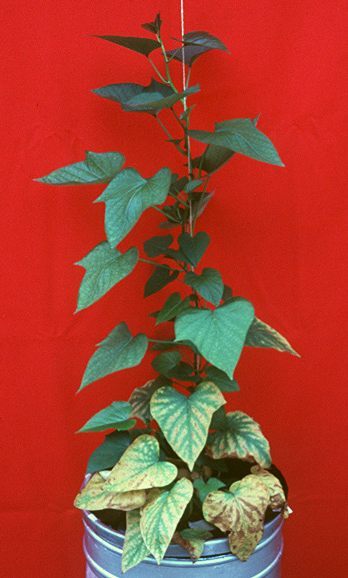
Symptoms of K deficiency induced in a plant in solution culture,
showing fine interveinal mottle on mid leaves, and yellowing and
necrosis in an interveinal to irregular pattern on oldest leaves (J.
O'Sullivan).
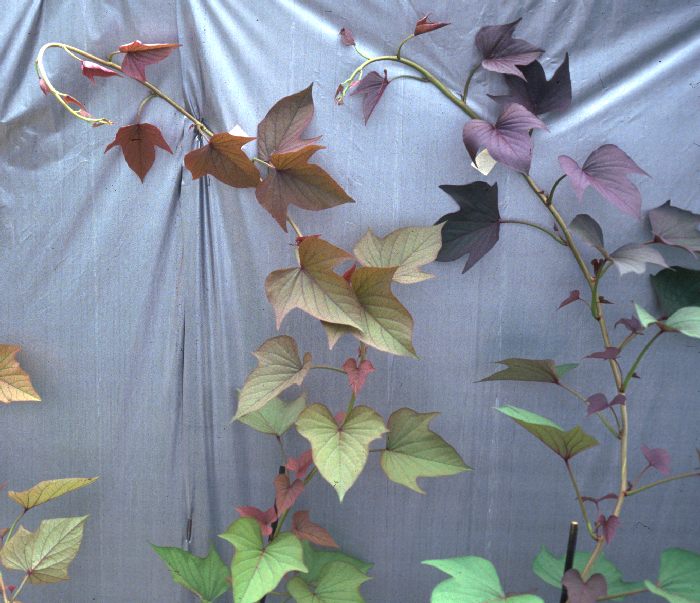
Normal shoot tip of a purple-tipped variety
(right) and a K-deficient plant of the same variety, showing reduction
in purple pigmentation (J. O'Sullivan).

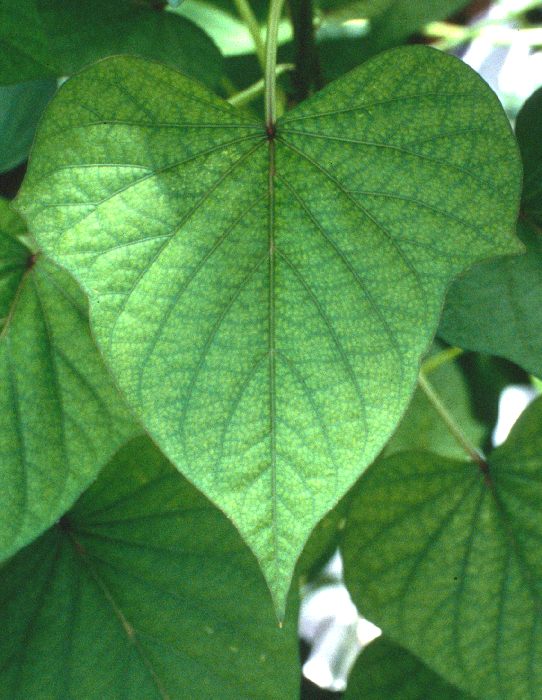
Examples of interveinal chlorosis on mature
leaves, with minor veins retaining a green margin (J. O'Sullivan).
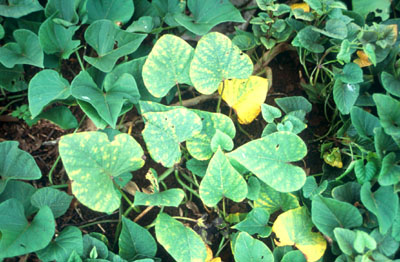
Interveinal yellowing of older leaves in a K-deficient crop (C.
Asher).
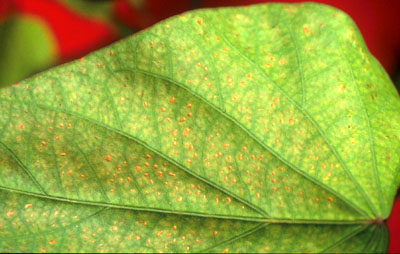
Small brown necrotic spots following interveinal yellowing in a mature leaf (J.
O'Sullivan).

Yellowing and brown necrosis spreading from margins between veins of older leaves (J.
O'Sullivan).

Thin, under-sized storage roots from a
K-deficient crop in PNG (R.M.
Bourke). |

